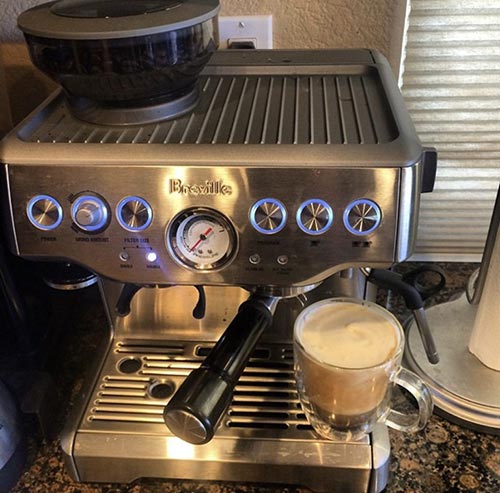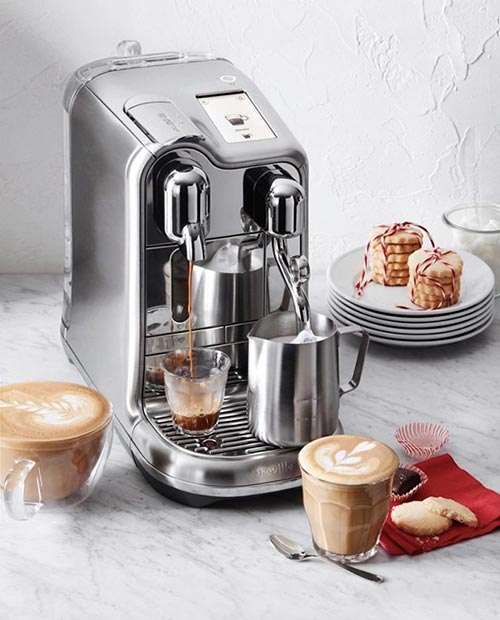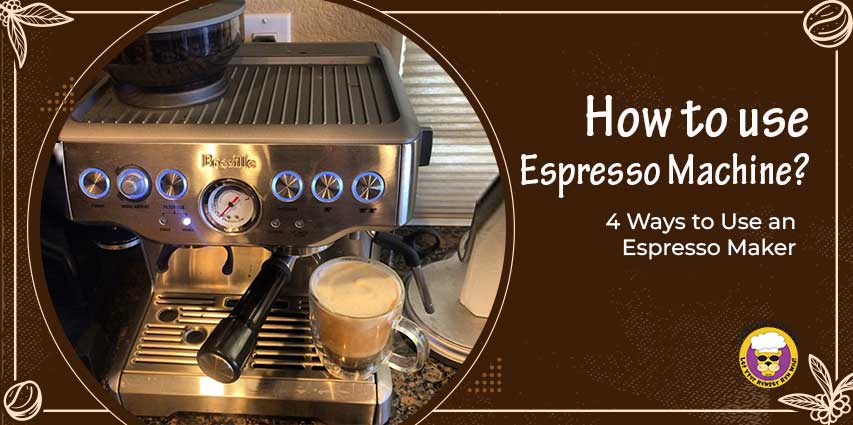If you want to share a delicious cup of espresso with your friends and family, there are several ways how to use Espresso machine. With an espresso machine, you can indulge in barista-level lattes and cappuccinos whenever it suits your schedule – not only that, but learning how to use an espresso machine is more straight forward than many people think.
In this blog post, we will cover all things related to using an espresso machine – from what tools and ingredients are needed to achieve cafe-quality results, all the way through maintenance and troubleshooting tips. Read on if you’re ready for next level caffeine!
How to use Espresso Machine?

Using an espresso machine can seem intimidating at first, but with a little practice, it can become a simple and enjoyable process. Here are the basic steps to use an espresso machine:
Fill the water tank:
First, fill the water tank with cold, filtered water. Make sure to follow the manufacturer’s instructions on the amount of water to use.
Preheat the machine:
Turn on the espresso machine and let it preheat for about 10-15 minutes. This will ensure that the machine is hot enough to properly extract the espresso.
Grind the coffee:
While the machine is heating up, grind fresh coffee beans to a fine consistency. The amount of coffee you need will depend on the size of your portafilter and the number of shots you want to make.
Tamp the coffee:
After grinding the coffee, tamp it down firmly into the portafilter. This will ensure that the coffee is evenly distributed and compacted, which will help to extract a balanced and flavorful espresso.
Brew the espresso:
Once the machine is preheated, lock the portafilter into the group head and start the brewing process. The espresso should start to pour out of the spout within a few seconds.
Stop the shot:
Stop the shot of espresso once you have brewed the desired amount, usually between 1-2 ounces for a single shot.
Clean the machine:
After brewing your espresso, be sure to clean the portafilter, group head, and steam wand to ensure that your machine stays in good working order.
With a little practice and experimentation, you can create delicious espresso drinks at home using your espresso machine.
What Is An Espresso Machine?
An espresso machine is a device used to brew a concentrated and flavorful coffee beverage called espresso. Espresso is made by forcing hot water through finely ground coffee beans at high pressure, resulting in a small shot of concentrated coffee with a layer of crema on top.
Espresso machines come in different sizes, types, and designs, but they all generally work by heating water to a specific temperature and then forcing it through the coffee grounds using high pressure. Some machines have additional features, such as a steam wand for frothing milk to make cappuccinos and lattes. Espresso machines can be found in coffee shops and cafes, but many people also purchase them for use at home to make their own espresso drinks.
Related aricle:
Best Espresso Machines Under 500 Dollars? Top Picks & Reviews 2023
How To Clean Delonghi Espresso Machine?
How To Clean Breville Espresso Machine?
How Does An Espresso Machine Work?

Espresso machines work by forcing hot water through finely ground coffee beans at high pressure, which extracts the rich and flavorful essence of the coffee into a concentrated shot. Here is a step-by-step breakdown of how an espresso machine works:
Water is heated:
The machine heats water to a specific temperature, usually between 190°F to 200°F (88°C to 93°C), using an electric heating element or boiler.
Coffee is ground:
Fresh coffee beans are ground into a fine powder, usually using a burr grinder.
Portafilter is filled:
The coffee grounds are measured and then evenly distributed into a metal portafilter.
Coffee is tamped:
The coffee grounds are then tamped down firmly into the portafilter, which creates a tight seal and ensures even extraction.
Water is forced through the coffee:
The portafilter is locked into the group head of the machine, and hot water is forced through the coffee grounds at high pressure, typically between 8 and 10 bars of pressure.
Espresso shot is extracted:
The hot water passes through the coffee and extracts the flavorful oils and compounds, resulting in a concentrated shot of espresso that is typically between 1 and 2 ounces.
Crema is formed:
As the espresso is extracted, it passes through a layer of fine bubbles and oils called crema, which gives the shot its distinctive appearance and texture.
Espresso machines can vary in design and functionality, but these basic steps are common to most machines. Many machines also have additional features, such as a steam wand for frothing milk or programmable settings for customized shots.
What You’ll Need to Make Espresso
To make espresso, you will need the following items:
Espresso machine: You will need an espresso machine to brew the coffee. Espresso machines can vary in size, type, and functionality, so be sure to choose one that meets your needs and budget.
Fresh coffee beans: The quality of your espresso will depend largely on the quality of your coffee beans. Look for beans that are freshly roasted and specifically labeled for espresso.
Burr grinder: To ensure the optimal extraction of flavor from the coffee beans, you will need a burr grinder to grind them into a fine, consistent powder.
Portafilter: This is the metal basket that holds the coffee grounds and attaches to the machine’s group head.
Tamper: A tamper is used to pack the coffee grounds firmly into the portafilter, ensuring even extraction and preventing the water from flowing through the coffee too quickly.
Scale: A scale can be used to weigh the coffee and ensure consistency in your brewing process.
Espresso cups: Espresso is typically served in small demitasse cups, which can hold about 2 to 3 ounces of liquid.
Milk frother (optional): If you want to make cappuccinos or lattes, you will also need a milk frother to create steamed and frothed milk.
By having these items and practicing, you will be able to make delicious espresso at home like a pro!
What Kind Of Coffee Do You Use In An Espresso Machine?
The type of coffee you use in an espresso machine is very important in determining the quality and taste of your espresso. For best results, you should use fresh, high-quality coffee beans that are specifically labeled for espresso.
Espresso beans are usually a blend of different coffee beans from various regions, which have been roasted to a dark and oily appearance to bring out the flavor and aroma of the coffee. The beans are typically roasted longer than those used for drip coffee to create a richer and more complex flavor profile.
When selecting coffee beans for your espresso machine, look for beans that have been freshly roasted within the past few weeks. This will ensure that the beans are at their peak freshness and will produce the best flavor in your espresso.
Avoid using pre-ground coffee, as it will not be as fresh and will not produce the same quality of espresso as freshly ground beans. Instead, invest in a burr grinder and grind your beans just before brewing to ensure maximum flavor and freshness.
4 Ways to Use an Espresso Maker
If you want to share a delicious cup of espresso with your friends and family, there are several ways how to use an Espresso Maker.
With an espresso machine, you can indulge in barista-level lattes and cappuccinos whenever it suits your schedule – not only that, but learning how to use an espresso machine is more straight forward than many people think. In this blog post, we will cover all things related to using an espresso machine – from what tools and ingredients are needed to achieve cafe-quality results, all the way through maintenance and troubleshooting tips. Read on if you’re ready for next level caffeine!
Make an Espresso Shot: The most common way to use an espresso maker is to make a single or double shot of espresso. Grind fresh coffee beans and pack them into the filter basket, then attach the portafilter to the grouphead and start the machine’s pump to force hot water through the coffee.
Make a Latte or Cappuccino: An espresso maker can also be used to make popular espresso-based drinks such as lattes and cappuccinos. Steam milk with the machine’s built-in steam wand and pour it over the espresso shot to create a creamy, frothy drink.
Brew Americano: An Americano is a popular coffee drink that’s made by adding hot water to an espresso shot. Start by brewing an espresso shot with the machine, then add hot water to the desired strength and serve.
Create Flavored Drinks: Espresso makers can also be used to make a variety of flavored drinks. Add flavored syrups such as vanilla or caramel to the espresso shot before adding the milk to create a customized drink. You can also experiment with different milk types such as almond or oat milk to create unique flavors.
FAQs:
Can you use regular coffee beans in an espresso machine?
Regular coffee beans are usually roasted lighter than espresso beans and ground coarser, which will not produce the same intense, full-bodied flavor and crema that espresso is known for. Additionally, regular coffee beans may not have the same oil content and acidity as espresso beans, which can affect the taste and extraction of the coffee.
If you do decide to use regular coffee beans in an espresso machine, you may need to adjust the grind size and the amount of coffee used to achieve a good extraction. However, for best results and to get the full flavor and crema that espresso is known for, it’s recommended to use beans specifically labeled for espresso.
How does a Simple Espresso Machine Work?
A simple espresso machine works by using pressure to force hot water through finely ground coffee to produce a concentrated shot of espresso.
Here are the basic steps:
- Water is heated in a boiler to a temperature of about 90-96°C (195-205°F).
- The user grinds fresh coffee beans and packs the grounds into a small, metal filter basket.
- The filter basket is locked into the machine’s portafilter, which is a handle with a metal basket attached to it.
- The portafilter is then attached to the espresso machine’s grouphead, which is a metal ring that holds the portafilter in place and directs hot water through the coffee.
- The user starts the machine’s pump, which forces hot water through the coffee in the portafilter at a high pressure of around 9 bars (130 psi).
- The hot water passes through the coffee and collects in a small cup or shot glass, producing a thick, concentrated shot of espresso.
- There are many variations of espresso machines, but the basic principles of using hot water and pressure to extract coffee remain the same.
How do Beginners Drink Espresso?
Drinking espresso can be an intense experience, especially for beginners who may not be accustomed to the strong, concentrated flavor. Here are some tips for beginners to enjoy their first espresso:
- Start with a small shot: A standard espresso shot is usually just 1-2 ounces, so start with a small size until you become accustomed to the strong taste.
- Sip it slowly: Sip the espresso slowly and let the flavors develop on your palate. Don’t gulp it down like a regular cup of coffee.
- Add sugar or milk: If you find the espresso too strong or bitter, you can add sugar or milk to taste. However, some espresso purists believe that adding milk or sugar detracts from the purity of the espresso flavor.
- Try different blends: Espresso can be made from a variety of coffee blends, each with its own unique flavor profile. Experiment with different blends to find one that suits your taste.
Enjoy with a small snack: Espresso is often enjoyed with a small snack, such as a biscotti or piece of chocolate. This can help balance the intensity of the espresso and enhance the overall experience. Remember that espresso is an acquired taste, and it may take some time to fully appreciate its complex flavors and aromas. With practice and experimentation, you can develop a taste for this classic coffee beverage.
Is espresso stronger than coffee?
Espresso is generally stronger than regular coffee in terms of flavor and caffeine content, but it’s important to note that “strength” can refer to different aspects of the beverage.
Flavor: Espresso has a stronger and more concentrated flavor than regular coffee due to the way it’s brewed. Espresso is made by forcing hot water through finely ground coffee under high pressure, resulting in a rich, full-bodied flavor with a crema (a layer of foam) on top. Regular coffee, on the other hand, is brewed by pouring hot water over coarser coffee grounds, resulting in a milder flavor.
Caffeine: In terms of caffeine content, a single shot of espresso typically contains about 40-75 milligrams of caffeine, while an 8-ounce cup of coffee contains about 95 milligrams of caffeine on average. However, since espresso is consumed in smaller quantities than regular coffee, the overall caffeine content of a cup of espresso may be lower than that of a cup of coffee.
So, in summary, espresso is generally stronger than coffee in terms of flavor, but may not be stronger in terms of caffeine content when consumed in equal amounts.
Q: What type of coffee should I use in my espresso machine?
A: We recommend using a blend that contains Arabica beans as they are known for producing better-tasting espresso. Darker roasts are also known to create a fuller-bodied and more complex flavor.
Q: How do I store my espresso beans?
A: Store your espresso beans in an airtight container and make sure to keep it away from heat, light and moisture. To maintain freshness, only grind the amount you will be using each time.
Q: How often should I clean my espresso machine?
A: We recommend cleaning your espresso machine after every use. This will help to keep your machine in good condition and ensure that you’re producing the best quality espresso possible. Be sure to read through your manual for specific cleaning instructions.
Q: What type of tamper should I use?
A: We recommend using a flat-tamper with a diameter slightly smaller than your portafilter. A flat-tamper will help evenly distribute the grounds with each use for optimal results.
Q1. What type of coffee beans should I use for espresso?
A1. You should use a blend that is specifically designed for espresso machines as it will give you the best flavor. The specific blend may vary depending on your machine and taste preferences – many manufacturers have their own signature blends available for purchase.
Q: How often should I descale my espresso machine?
A: We recommend descaling your espresso machine every 2 to 3 months, or more frequently if you live in a hard water area. This will help keep your machine running smoothly and ensure that you’re producing the best quality espresso possible. Be sure to read through your manual for specific descaling instructions.
Hopefully this blog post has given you a better understanding of how to use an espresso maker, as well as what tools and ingredients are needed in order to achieve the best quality espresso. With a few simple steps and some practice, you’ll soon be crafting barista-level espresso drinks without ever having to leave your home! Happy brewing!
Conclusion: How to use Espresso machine
Espresso makers can be an incredibly valuable share to any kitchen, allowing you to enjoy the delicious taste and smoothness of quality espresso drinks right at home. There are several different ways that you can use an espresso maker to prepare a variety of barista-style espresso beverages.
Four primary methods include single-shot brewing, double shot brewing, pressurized portafilter packing and non-pressurized portafilter packing. Depending on your preference and set up, you can use any one of these methods to make sure that you starting your day off with the perfect cup of espresso!

I’m Kara Chavez, and I love coffee. I like to create some of the best coffees around – espressos, lattes, macchiatos . I strive for perfection in my coffee-making skills, and I take great pride in providing a delicious cup of joe to my customers.
I’ve been working in the coffee industry for years now, and I know everything there is to know about making a perfect cup of coffee. My passion for coffee shines through in every cup that I make, and I hope that you’ll stop by soon so that I can share my love of coffee with you!


Thank you very much for the useful article you have published. I am the owner of two coffee shops in Iran, and I was confused when working with the coffee maker. Fortunately, so by reading this article, I learned how to make coffee well.